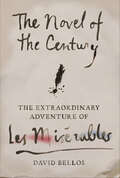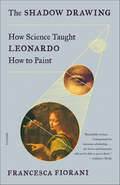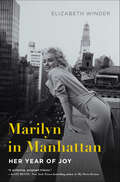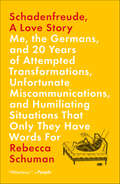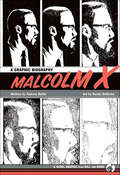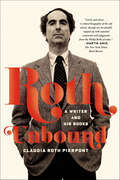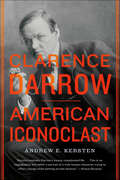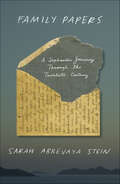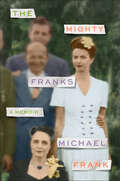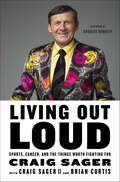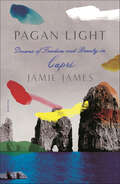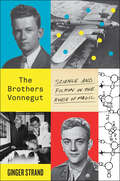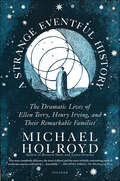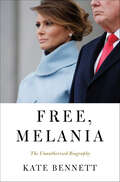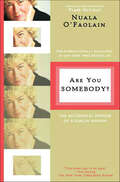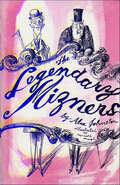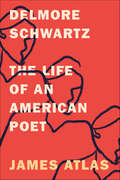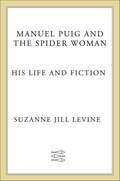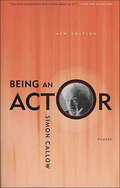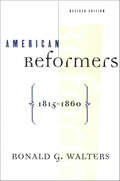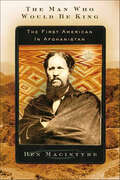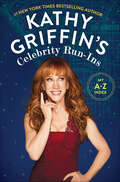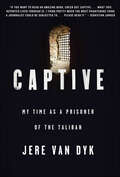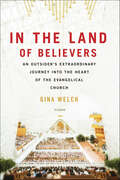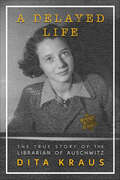- Table View
- List View
The Novel of the Century: The Extraordinary Adventure of Les Misérables
by David BellosA New York Times Book Review Editors' Choice Winner of the American Library in Paris Book Award, 2017Les Misérables is among the most popular and enduring novels ever written. Like Inspector Javert’s dogged pursuit of Jean Valjean, its appeal has never waned, but only grown broader in its one-hundred-and-fifty-year life. Whether we encounter Victor Hugo’s story on the page, onstage, or on-screen, Les Misérables continues to captivate while also, perhaps unexpectedly, speaking to contemporary concerns. In The Novel of the Century, the acclaimed scholar and translator David Bellos tells us why.This enchanting biography of a classic of world literature is written for “Les Mis” fanatics and novices alike. Casting decades of scholarship into accessible narrative form, Bellos brings to life the extraordinary story of how Victor Hugo managed to write his novel of the downtrodden despite a revolution, a coup d’état, and political exile; how he pulled off a pathbreaking deal to get it published; and how his approach to the “social question” would define his era’s moral imagination. More than an ode to Hugo’s masterpiece, The Novel of the Century also shows that what Les Misérables has to say about poverty, history, and revolution is full of meaning today.
The Shadow Drawing: How Science Taught Leonardo How to Paint
by Francesca Fiorani"[The Shadow Drawing] reorients our perspective, distills a life and brings it into focus—the very work of revision and refining that its subject loved best." —Parul Sehgal, The New York Times | Editors' ChoiceAn entirely new account of Leonardo the artist and Leonardo the scientist, and why they were one and the same manLeonardo da Vinci has long been celebrated for his consummate genius. He was the painter who gave us the Mona Lisa and The Last Supper, and the inventor who anticipated the advent of airplanes, hot air balloons, and other technological marvels. But what was the connection between Leonardo the painter and Leonardo the scientist? Historians of Renaissance art have long supposed that Leonardo became increasingly interested in science as he grew older and turned his insatiable curiosity in new directions. They have argued that there are, in effect, two Leonardos—an artist and an inventor. In this pathbreaking new interpretation, the art historian Francesca Fiorani offers a different view. Taking a fresh look at Leonardo’s celebrated but challenging notebooks, as well as other sources, Fiorani argues that Leonardo became familiar with advanced thinking about human vision when he was still an apprentice in a Florence studio—and used his understanding of optical science to develop and perfect his painting techniques. For Leonardo, the task of the painter was to capture the interior life of a human subject, to paint the soul. And even at the outset of his career, he believed that mastering the scientific study of light, shadow, and the atmosphere was essential to doing so. Eventually, he set down these ideas in a book—A Treatise on Painting—that he considered his greatest achievement, though it would be disfigured, ignored, and lost in subsequent centuries. Ranging from the teeming streets of Florence to the most delicate brushstrokes on the surface of the Mona Lisa, The Shadow Drawing vividly reconstructs Leonardo’s life while teaching us to look anew at his greatest paintings. The result is both stirring biography and a bold reconsideration of how the Renaissance understood science and art—and of what was lost when that understanding was forgotten.
Marilyn in Manhattan: Her Year of Joy
by Elizabeth WinderA city, a movie star, and one magical year.In November of 1954 a young woman dressed plainly in a white oxford, dark sunglasses and a black pageboy wig boards a midnight flight from Los Angeles to New York. As the plane’s engines rev she breathes a sigh of relief, lights a cigarette and slips off her wig revealing a tangle of fluffy blonde curls. Marilyn Monroe was leaving Hollywood behind, and along with it a failed marriage and a frustrating career. She needed a break from the scrutiny and insanity of LA. She needed Manhattan. In Manhattan, the most famous woman in the world can wander the streets unbothered, spend hours at the Met getting lost in art, and afternoons buried in the stacks of the Strand. Marilyn begins to live a life of the mind in New York; she dates Arthur Miller, dances with Truman Capote and drinks with Carson McCullers. Even though she had never lived there before, in New York, Marilyn is home.In Marilyn in Manhattan, the iconic blonde bombshell is not only happy, but successful. She breaks her contract with Fox Studios to form her own production company, a groundbreaking move that makes her the highest paid actress in history and revolutionizes the entertainment industry. A true love letter to Marilyn, and a joyous portrait of a city bursting with life and art, Marilyn in Manhattan is a beautifully written, lively look at two American treasures: New York and Marilyn Monroe, and sheds new light on one of our most enduring icons.
Schadenfreude, A Love Story
by Rebecca Schuman"This book is a wild and wonderful ride. Your guide, Rebecca Schuman, is a super-smart and very funny person who writes brilliantly about Germany and Germans (who are not what you think) and being young and insane and life in general and… just read it, OK?"-Dave BarrySometimes Love Gets Lost in TranslationYou know that feeling you get watching the elevator doors slam shut just before your toxic coworker can step in? Or seeing a parking ticket on a Hummer? There’s a word for this mix of malice and joy, and the Germans (of course) invented it. It’s Schadenfreude, deriving pleasure from others’ misfortune. Misfortune happens to be a specialty of Slate columnist Rebecca Schuman—and this is great news for the Germans. For Rebecca adores the Vaterland with the kind of single-minded passion its Volk usually reserve for beer, soccer, and being right all the time. Let’s just say the affection isn’t mutual. Schadenfreude is the story of a teenage Jewish intellectual who falls in love – in love with a boy (who breaks her heart), a language (that’s nearly impossible to master), a culture (that’s nihilistic, but punctual), and a landscape (that’s breathtaking when there’s not a wall in the way). Rebecca is an everyday, misunderstood 90’s teenager with a passion for Pearl Jam and Ethan Hawke circa Reality Bites, until two men walk into her high school Civics class: Dylan Gellner, with deep brown eyes and an even deeper soul, and Franz Kafka, hitching a ride in Dylan’s backpack. These two men are the axe to the frozen sea that is Rebecca’s spirit, and what flows forth is a passion for all things German. First love might be fleeting, but Kafka is forever, and in pursuit of this elusive passion Rebecca will spend two decades stuttering and stumbling through German sentences, trying to win over a people who can’t be bothered. At once a snapshot of a young woman finding herself, and a country slowly starting to stitch itself back together after nearly a century of war (both hot and cold), Schadenfreude, A Love Story is an exhilarating, hilarious, and yes, maybe even heartfelt memoir proving that sometimes the truest loves play hard to get.
Malcolm X: A Graphic Biography
by Andrew HelferThe age of multitasking needs better narrative history. It must be absolutely factual, immediately accessible, smart, and brilliantly fun. Enter Andrew Helfer, the award-winning graphic-novel editor behind Roadto Perdition and The History of Violence, and welcome the launch of a unique line of graphic biographies.If a picture is worth a thousand words, these graphic biographies qualify as tomes. But if you're among the millions who haven't time for another doorstop of a biography, these books are for you.With the thoroughly researched and passionately drawn Malcolm X, Helfer and award-winning artist Randy DuBurke capture Malcolm Little's extraordinary transformation from a black youth beaten down by Jim Crow America into Malcolm X, the charismatic, controversial, and doomed national spokesman for the Nation of Islam.
Roth Unbound: A Writer and His Books
by Claudia Roth PierpontA critical evaluation of Philip Roth—the first of its kind—that takes on the man, the myth, and the workPhilip Roth is one of the most renowned writers of our time. From his debut, Goodbye, Columbus, which won the National Book Award in 1960, and the explosion of Portnoy's Complaint in 1969 to his haunting reimagining of Anne Frank's story in The Ghost Writer ten years later and the series of masterworks starting in the mid-eighties—The Counterlife, Patrimony, Operation Shylock, Sabbath's Theater, American Pastoral, The HumanStain—Roth has produced some of the great American literature of the modern era. And yet there has been no major critical work about him until now. Here, at last, is the story of Roth's creative life. Roth Unbound is not a biography—though it contains a wealth of previously undisclosed biographical details and unpublished material—but something ultimately more rewarding: the exploration of a great writer through his art. Claudia Roth Pierpont, a staff writer for The New Yorker, has known Roth for nearly a decade. Her carefully researched and gracefully written account is filled with remarks from Roth himself, drawn from their ongoing conversations. Here are insights and anecdotes that will change the way many readers perceive this most controversial and galvanizing writer: a young and unhappily married Roth struggling to write; a wildly successful Roth, after the uproar over Portnoy, working to help writers from Eastern Europe and to get their books known in the West; Roth responding to the early, Jewish—and the later, feminist—attacks on his work. Here are Roth's family, his inspirations, his critics, the full range of his fiction, and his friendships with such figures as Saul Bellow and John Updike. Here is Roth at work and at play.Roth Unbound is a major achievement—a highly readable story that helps us make sense of one of the most vital literary careers of the twentieth and twenty-first centuries.
Clarence Darrow: American Iconoclast
by Andrew E. KerstenClarence Darrow is best remembered for his individual cases, whether defending the thrill killers Leopold and Loeb or John Scopes's right to teach evolution in the classroom. In the first full-length biography of Darrow in decades, the historian Andrew E. Kersten narrates the complete life of America's most legendary lawyer and the struggle that defined it, the fight for the American traditions of individualism, freedom, and liberty in the face of the country's inexorable march toward modernity. Prior biographers have all sought to shoehorn Darrow, born in 1857, into a single political party or cause. But his politics do not define his career or enduring importance. Going well beyond the familiar story of the socially conscious lawyer and drawing upon new archival records, Kersten shows Darrow as early modernity's greatest iconoclast. What defined Darrow was his response to the rising interference by corporations and government in ordinary working Americans' lives: he zealously dedicated himself to smashing the structures and systems of social control everywhere he went. During a period of enormous transformations encompassing the Gilded Age and the Progressive Era, Darrow fought fiercely to preserve individual choice as an ever more corporate America sought to restrict it.
Family Papers: A Sephardic Journey Through the Twentieth Century
by Sarah Abrevaya SteinNamed one of the best books of 2019 by The Economist and a New York Times Book Review Editors' Choice. A National Jewish Book Award finalist."A superb and touching book about the frailty of ties that hold together places and people." --The New York Times Book ReviewAn award-winning historian shares the true story of a frayed and diasporic Sephardic Jewish family preserved in thousands of lettersFor centuries, the bustling port city of Salonica was home to the sprawling Levy family. As leading publishers and editors, they helped chronicle modernity as it was experienced by Sephardic Jews across the Ottoman Empire. The wars of the twentieth century, however, redrew the borders around them, in the process transforming the Levys from Ottomans to Greeks. Family members soon moved across boundaries and hemispheres, stretching the familial diaspora from Greece to Western Europe, Israel, Brazil, and India. In time, the Holocaust nearly eviscerated the clan, eradicating whole branches of the family tree. In Family Papers, the prizewinning Sephardic historian Sarah Abrevaya Stein uses the family’s correspondence to tell the story of their journey across the arc of a century and the breadth of the globe. They wrote to share grief and to reveal secrets, to propose marriage and to plan for divorce, to maintain connection. They wrote because they were family. And years after they frayed, Stein discovers, what remains solid is the fragile tissue that once held them together: neither blood nor belief, but papers.With meticulous research and care, Stein uses the Levys' letters to tell not only their history, but the history of Sephardic Jews in the twentieth century.
The Mighty Franks: A Memoir
by Michael FrankWINNER OF THE 2018 JG-WINGATE PRIZE A psychologically acute memoir about an unusual Hollywood family by Michael Frank, who "brings Proustian acuity and razor-sharp prose to family dramas as primal, and eccentrically insular, as they come" (The Atlantic)“My feeling for Mike is something out of the ordi - nary,” Michael Frank overhears his aunt telling his mother when he is a boy of eight. “It’s stronger than I am. I cannot explain it . . . I love him beyond life itself.” With this indelible bit of eavesdropping, we fall into the spellbinding world of The Mighty Franks. The family is uncommonly close: Michael’s childless Auntie Hankie and Uncle Irving, glamorous Hollywood screenwriters, are doubly related— Hankie is his father’s sister, and Irving is his mother’s brother. The two families live near each other in Laurel Canyon. In this strangely intertwined world, even the author’s grandmothers—who dislike each other—share a nearby apartment. Strangest of all is the way Auntie Hankie, with her extravagant personality, comes to bend the wider family to her will. Talented, mercurial, and lavish with her love, she divides Michael from his parents and his two younger brothers as she takes charge of his education, guiding him to the right books to read (Proust, not Zola), the right painters to admire (Matisse, not Pollock), the right architectural styles to embrace (period, not modern—or mo-derne, as she pronounces the word, with palpable disdain). She trains his mind and his eye—until that eye begins to see on its own. When this “son” Hankie longs for grows up and begins to turn away from her, her moods darken, and a series of shattering scenes compel Michael to reconstruct both himself and his family narrative as he tries to reconcile the woman he once adored with the troubled figure he discovers her to be. In its portrayal of this fascinating, singularly polarizing figure, the boy in her thrall, and the man that boy becomes, The Mighty Franks will speak to any reader who has ever struggled to find an independent voice amid the turbulence of family life.
Living Out Loud: Sports, Cancer, and the Things Worth Fighting For
by Brian Curtis Craig Sager IINew York Times BestsellerA moving and inspiring memoir from the beloved sports broadcaster Craig Sager on his battle with leukemia and how he maintained a positive outlook on life in face of incredible circumstances.“Time is something that cannot be bought, it cannot be wagered with God, and it is not in endless supply. Time is simply how you live your life.” —Craig SagerThanks to an eccentric wardrobe filled with brightly colored suits and a love of sports that knows no bounds, Craig Sager is one of the most beloved and recognizable broadcasters on television. So when the sports world learned that he was diagnosed with acute myeloid leukemia (AML) there was an outpouring of love and support from everyone who was inspired by his colorful life and his fearless decision to continue doing the job he loved—despite being told that he would have only three-to-six months to live. Sager has undergone three stem cell transplants—with his son as the donor for two of them—and more than twenty chemotherapy cycles since his diagnosis.In Living Out Loud, Craig Sager shares incredible stories from his remarkable career and chronicles his heroic battle. Whether he’s sprinting across Wrigley Field mid-game as a college student with cops in pursuit, chasing down Hank Aaron on the field for an interview after Aaron broke Babe Ruth’s home run record, running with the bulls in Pamplona, or hunkering down to face the daunting physical challenges of fighting leukemia, Craig Sager is always ready to defy expectations, embrace life, and live it to the fullest.Including a foreword by Charles Barkley and with unique insight from his son Craig Sager II, this entertaining, honest, and introspective account of a life lived in sports reveals the enduring lessons Sager has learned throughout his career and reminds you that no matter what life throws at you, to always look at the bright side.
Pagan Light: Dreams of Freedom and Beauty in Capri
by Jamie JamesA New York Times Book Review Editors' Choice"Pagan Light is mesmerizing. Every detail is compelling. I felt I was reading a family history of a family far more interesting than mine." --Edmund White, author of Our Young ManA rich, intimate embrace of Capri, which was a magnet for artistic renegades and a place of erotic refugeIsolated and arrestingly beautiful, the island of Capri has been a refuge for renegade artists and writers fleeing the strictures of conventional society from the time of Augustus, who bought the island in 29 BC after defeating Antony and Cleopatra, to the early twentieth century, when the poet and novelist Jacques d’Adelswärd-Fersen was in exile there after being charged with corrupting minors, to the 1960s, when Truman Capote spent time on the island. We also meet the Marquis de Sade, Goethe, Mark Twain, Oscar Wilde, Compton Mackenzie, Rilke, Lenin, and Gorky, among other astonishingly vivid characters. Grounded in a deep intimacy with Capri and full of captivating anecdotes, Jamie James’s Pagan Light tells how a tiny island served as a wildly permissive haven for people—queer, criminal, sick, marginalized, and simply crazy—who had nowhere else to go.
The Brothers Vonnegut: Science and Fiction in the House of Magic
by Ginger StrandWorlds collide in this true story of weather control in the Cold War era and the making of Kurt VonnegutIn the mid-1950s, Kurt Vonnegut takes a job in the PR department at General Electric in Schenectady, where his older brother, Bernard, is a leading scientist in its research lab--or "House of Magic." Kurt has ambitions as a novelist, and Bernard is working on a series of cutting-edge weather-control experiments meant to make deserts bloom and farmers flourish.While Kurt writes zippy press releases, Bernard builds silver-iodide generators and attacks clouds with dry ice. His experiments attract the attention of the government; weather proved a decisive factor in World War II, and if the military can control the clouds, fog, and snow, they can fly more bombing missions. Maybe weather will even be the "New Super Weapon." But when the army takes charge of his cloud-seeding project (dubbed Project Cirrus), Bernard begins to have misgivings about the harmful uses of his inventions, not to mention the evidence that they are causing alarming changes in the atmosphere.In a fascinating cultural history, Ginger Strand chronicles the intersection of these brothers' lives at a time when the possibilities of science seemed infinite. As the Cold War looms, Bernard's struggle for integrity plays out in Kurt's evolving writing style. The Brothers Vonnegut reveals how science's ability to influence the natural world also influenced one of our most inventive novelists.
A Strange Eventful History: The Dramatic Lives of Ellen Terry, Henry Irving, and Their Remarkable Families
by Michael HolroydPLEASE NOTE: THIS EBOOK DOES NOT CONTAIN PHOTOS INCLUDED IN THE PRINT EDITION.Deemed "a prodigy among biographers" by The New York Times Book Review, Michael Holroyd transformed biography into an art. Now he turns his keen observation, humane insight, and epic scope on an ensemble cast, a remarkable dynasty that presided over the golden age of theater.Ellen Terry was an ethereal beauty, the child bride of a Pre-Raphaelite painter who made her the face of the age. George Bernard Shaw was so besotted by her gifts that he could not bear to meet her, lest the spell she cast from the stage be broken. Henry Irving was an ambitious, harsh-voiced merchant's clerk, but once he painted his face and spoke the lines of Shakespeare, his stammer fell away to reveal a magnetic presence. He would become one of the greatest actor-managers in the history of the theater. Together, Terry and Irving created a powerhouse of the arts in London's Lyceum Theatre, with Bram Stoker—who would go on to write Dracula—as manager. Celebrities whose scandalous private lives commanded global attention, they took America by stormin wildly popular national tours.Their all-consuming professional lives left little room for their brilliant but troubled children. Henry's boys followed their father into the theater but could not escape the shadow of his fame. Ellen's feminist daughter, Edy, founded an avant-garde theater and a largely lesbian community at her mother's country home. But it was Edy's son, the revolutionary theatrical designer Edward Gordon Craig, who possessed the most remarkable gifts and the most perplexing inability to realize them. A now forgotten modernist visionary, he collaborated with the Russian director Stanislavski on a production of Hamlet that forever changed the way theater was staged. Maddeningly self-absorbed, he inherited his mother's potent charm and fathered thirteen children by eight women, including a daughter with the dancer Isadora Duncan.An epic story spanning a century of cultural change, A Strange Eventful History finds space for the intimate moments of daily existence as well as the bewitching fantasies played out by its subjects. Bursting with charismatic life, it is an incisive portrait of two families who defied the strictures of their time. It will be swiftly recognized as a classic.Please note: This ebook edition does not contain photos and illustrations that appeared in the print edition.
Free, Melania: The Unauthorized Biography
by Kate BennettThe first behind-the-scenes look at the life of the most enigmatic First Lady in U.S. historyMelania Trump is an enigma. Regardless of your political leanings, she is fascinating—a First Lady who, in many ways, is the most modern and groundbreaking in recent history. A former model whose beauty in person leaves people breathless, a woman whose upbringing in a communist country spurred a relentless drive for stability, both for herself and for her family. A reluctant pillar in a controversial presidential administration who speaks five languages and runs the East Wing like none of her predecessors ever could—underestimate her at your own peril (as a former government official did and was summarily fired). But who is she really?In Free, Melania we get an insider's look at Melania Trump, from her childhood in Slovenia to her days in the White House, and everything in between. We see the Trump family dynamics that Melania has had to navigate, including her strained relationship with Ivanka. We get a rare glimpse into what goes into her famous and sometimes infamous clothing choices (including perhaps the real message behind Melania’s controversial jacket, “I Really Don’t Care, Do U?”, which she wore while visiting the U.S.-Mexico border), and how a publicly quiet Melania actually speaks very loudly—if you just know where, and how, to listen. And we get a behind-the-scenes look at her often eyebrow-raising relationship with Donald Trump, from their beginnings to becoming the most unusual First Family in modern history.Looking at Melania in the pantheon of historic First Ladies, Kate Bennett shows just how different Melania Trump is and why she matters. Bennett, an expert on First Ladies, has unparalleled access to Melania’s very small and loyal inner circle. As she shows in this page-turning book, the seemingly most reluctant First Lady is, in many ways, the most compelling and complex First Lady, ever.
Are You Somebody?: The Accidental Memoir of a Dublin Woman
by Nuala O'Faolain"You don't want the book to end; it glows with compassion and you want more, more because you know this is a fine wine of a life, richer as it ages."—Frank McCourt, author of Angela's AshesOne of nine children born into a penniless North Dublin family, Nuala O'Faolain was saved from a harrowing childhood by her love of books and reading. Though she ultimately became one of Ireland's best-known columnists, her professional success did little to ease her loneliness and longing for a deep connection to the world. Are You Somebody? distills her experiences into a wisdom that can only come from an obstinate refusal to shrink from life.This commemorative edition of her landmark memoir celebrates O'Faolain's remarkable life and work with a new foreword from Frank McCourt as well as additional archival materials. Strikingly vivid and starkly emotional, Are You Somebody? is, like O'Faolain herself, a singular example of courage, honesty, and bold living.
The Legendary Mizners
by Alva JohnstonThe real-life adventures of Addison and Wilson Mizner, the subjects of the Stephen Sondheim musical Gold!Alva Johnston's joint biography of Addison and Wilson Mizner is a delightful portrait of two of the early twentieth century's most clever and infamous rascals. Born in the 1870s in California, the brothers quickly rose to prominence during the various booms of the 1920s.Addison, the elder, was a self-made architect and real-estate dealer who designed many of the fantastic homes of the fantastically rich in Palm Beach. He could "age" a house and its furnishings to any period his client desired--and would pay for. Wilson's adventures were even more daring and varied, and his quick wit was legendary. In addition to getting rich on the Alaskan gold rush, he had careers as a singer, playwright, prizefight promoter, con man, real-estate salesman, and shady hotel owner. Perhaps his most famous quip was one he delivered on being told that President Coolidge had died: "How do they know?"
Delmore Schwartz: The Life of an American Poet
by James AtlasDelmore Schwartz: The Life of an American Poet is based on interviews, letters, and an extraordinary collection of unpublished papers that had never before been examined. Delmore Schwartz was only twenty-four in 1938 when his first book, In Dreams Begin Responsibilities, was published. He received praise from T. S. Eliot, Ezra Pound, Allen Tate, John Crowe Ransom, Wallace Stevens, and William Carlos Williams. For Tate, it was “the only genuine innovation we’ve had since Eliot and Pound.” A decade later, the short-story collection The World Is a Wedding was published; many critics characterized it as the definitive portrait of their generation.In this biography, the first about the man whom John Berryman called “the most underrated poet of the twentieth century,” James Atlas traces Schwartz’s history, from the arrival of his Romanian ancestors in New York, to his youth in Washington Heights, to his career at Harvard as a graduate student in philosophy, and onward to the flowering of his generation in the '40s, when he and the critics, poets, and novelists who were his friends made their reputations. Schwartz’s brilliant satires of his friends and acquaintances, his autobiographical stories, and his letters to his illustrious peers contribute to this vivid portrait of an era—and of that era’s most trenchant chronicler.
Manuel Puig and the Spider Woman: His Life and Fiction
by Suzanne Jill LevineManuel Puig & The Spider Woman tells the life story of the innovative and flamboyant novelist and playwright himself. Suzanne Jill Levine, his principal English translator, draws upon years of friendship as well as copious research and interviews in her remarkable book, the first biography of the inimitable writer. Manuel Puig (1932-1990), Argentinian author of Kiss of the Spider Woman and pioneer of high camp, stands alone in the pantheon of contemporary Latin American literature. Strongly influenced by Hollywood films of the thirties and forties, his many-layered novels and plays integrate serious fiction and popular culture, mixing political and sexual themes with B-movie scenarios. When his first two novels were published in the late 1960s, they delighted the public but were dismissed as frivolous by the leftist intellectuals of the Boom; his third novel was banned by the Peronist government for irreverence. His influence was already felt, though-even by writers who had dismissed him-and by the time the film version of Kiss of the Spider Woman became a worldwide hit, he was a renowned literary figure.Puig's way of life was as unconventional as his fiction: he spoke of himself in the female form in Spanish, renamed his friends for his favorite movie stars, referred to his young male devotees as "daughters," and, as a perennial expatriate, lived (often with his mother) everywhere from Rome to Rio de Janeiro.
Being an Actor
by Simon CallowA new edition of the classic book for actors starting their careers, with new materialFew actors have ever been more eloquent, more honest, or more entertaining about their life and their profession than Simon Callow, one of the finest actors of his time and increasingly one of the most admired writers about the theater.Beginning with the letter to Laurence Olivier that produced his first theatrical job to his triumph as Mozart in the original production of Amadeus, Callow takes us with him on his progress through England's rich and demanding theater: his training at London's famed Drama Centre, his grim and glorious apprenticeship in the provincial theater, his breakthrough at the Joint Stock Company, and then success at Olivier's National Theatre are among the way stations.Callow provides a guide not only to the actor's profession but also to the intricacies of his art, from unemployment—"the primeval slime from which all actors emerge and to which, inevitably, they return"—to the last night of a long run.
American Reformers, 1815–1860
by Ronald G. WaltersFor this new edition of American Reformers 1815-1860, Ronald G. Walters has amplified and updated his exploration of the fervent and diverse outburst of reform energy that shaped American history in the early years of the Republic. Capturing in style and substance the vigorous and often flamboyant men and women who crusaded for such causes as abolition, temperance, women's suffrage, and improved health care, Walters presents a brilliant analysis of how the reformers' radical belief that individuals could fix what ailed America both reflected major transformations in antebellum society and significantly affected American culture as a whole.
The Man Who Would Be King: The First American in Afghanistan
by Ben MacintyreThe Man Who Would Be King is the riveting story that inspired Kipling's classic tale and a John Huston movieIn the year 1838, a young adventurer, surrounded by his native troops and mounted on an elephant, raised the American flag on the summit of the Hindu Kush in the mountainous wilds of Afghanistan. He declared himself Prince of Ghor, Lord of the Hazarahs, spiritual and military heir to Alexander the Great.The true story of Josiah Harlan, a Pennsylvania Quaker and the first American ever to enter Afghanistan, has never been told before, yet the life and writings of this extraordinary man echo down the centuries, as America finds itself embroiled once more in the land he first explored and described 180 years ago.Soldier, spy, doctor, naturalist, traveler, and writer, Josiah Harlan wanted to be a king, with all the imperialist hubris of his times. In an extraordinary twenty-year journey around Central Asia, he was variously employed as surgeon to the Maharaja of Punjab, revolutionary agent for the exiled Afghan king, and then commander in chief of the Afghan armies. In 1838, he set off in the footsteps of Alexander the Great across the Hindu Kush and forged his own kingdom, only to be ejected from Afghanistan a few months later by the invading British.Using a trove of newly discovered documents and Harlan's own unpublished journals, Ben Macintyre's The Man Who Would Be King tells the astonishing true story of the man who would be the first and last American king.
Kathy Griffin's Celebrity Run-Ins: My A–Z Index
by Kathy GriffinFrom #1 New York Times bestselling author Kathy Griffin, an A-Z compendium of her celebrity run-ins, and the jaw-dropping, charming, and sometimes bizarre anecdotes only she can tell about them.Kathy Griffin’s Celebrity Run-Ins is Kathy’s funny, juicy index of all of the celebrities she has met during her many years in show business, bursting with never-before-told stories. Starting with Woody Allen and ending with Warren Zevon, Kathy Griffin’s Celebrity Run-Ins is a who’s who of pop culture: Leonardo DiCaprio, Nick Jonas, Kendall Jenner, Anna Kendrick, Lily Tomlin, Suge Knight, Barbra Streisand, Ashton Kutcher, Queen Latifah, Maria Shriver, Jared Leto, Selena Gomez, Meghan Trainor, Macklemore, Bruno Mars, Aaron Paul, Pink, Pitbull, Sia, Britney Spears, Taylor Swift, Christina Aguilera, and many more. Who would imagine that Kathy was an extra in a Michael Jackson commercial (guess which one)? That she and Salman Rushdie trade celebrity stories? That Donald Trump once drove Kathy and Liza Minelli around on a golf cart? That Sidney Poitier has a wicked sense of humor? That Demi Lovato has none? That David Letterman is still scared of Cher? That Channing Tatum is as polite as they come, and Tom Hanks might have the best perspective on fame of anyone? Kathy, that’s who. Kathy has met everyone, and after reading this book, you will feel as if you have, too. Kathy Griffin has seen it all. Shocking and sidesplitting, Kathy Griffin’s Celebrity Run-Ins is an indispensable guide to the stars from one of our most beloved comedians. Can you handle it?
Captive: My Time as a Prisoner of the Taliban
by Jere Van DykAn American reporter's chilling account of being kidnapped and imprisoned by the Taliban, in the no-man's-land between Afghanistan and PakistanJere Van Dyk was on the wrong side of the border. He and three Afghan guides had crossed into the tribal areas of Pakistan, where no Westerner had ventured for years, hoping to reach the home of a local chieftain by nightfall. But then a dozen armed men in black turbans appeared over the crest of a hill. Captive is Van Dyk's searing account of his forty-five days in a Taliban prison, and it is gripping and terrifying in the tradition of the best prison literature. The main action takes place in a single room, cut off from the outside world, where Van Dyk feels he can trust nobody—not his jailers, not his guides (who he fears may have betrayed him), and certainly not the charismatic Taliban leader whose fleeting appearances carry the hope of redemption as well as the prospect of immediate, violent death. Van Dyk went to the tribal areas to investigate the challenges facing America there. His story is of a deeper, more personal challenge, an unforgettable tale of human endurance.
In the Land of Believers: An Outsider's Extraordinary Journey into the Heart of the Evangelical Church
by Gina WelchAn undercover exploration of the world of evangelicals, offering an extraordinary behind-the-scenes look at the faithfulEver since evangelical Christians rose to national prominence, mainstream America has tracked their every move with a nervous eye. But in spite of this vigilance, our understanding hasn't gone beyond the caricatures. Who are evangelicals, really? What are they like in private, and what do they want? Is it possible that beneath the differences in culture and language, church and party, we might share with them some common purpose?To find out, Gina Welch, a young secular Jew from Berkeley, joined Jerry Falwell's Thomas Road Baptist Church. Over the course of nearly two years, Welch immersed herself in the life and language of the devout: she learned to interpret the world like an evangelical, weathered the death of Falwell, and embarked on a mission trip to Alaska intended to save one hundred souls. Alive to the meaning behind the music and the mind behind the slogans, Welch recognized the allure of evangelicalism, even for the godless, realizing that the congregation met needs and answered questions she didn't know she had. What emerges is a riveting account of a skeptic's transformation from uninformed cynicism to compassionate understanding, and a rare view of how evangelicals see themselves. Revealing their generosity and hopefulness, as well as their prejudice and exceptionalism, In the Land of Believers is a call for comprehending, rather than dismissing, the impassioned believers who have become so central a force in American life.
A Delayed Life: The True Story of the Librarian of Auschwitz
by Dita KrausA Delayed Life is the breathtaking memoir that tells the story of Dita Kraus, the real-life Librarian of Auschwitz.Dita Kraus grew up in Prague in an intellectual, middle-class Jewish family. She went to school, played with her friends, and never thought of herself as being different—until the advent of the Holocaust. Torn from her home, Dita was sent to Auschwitz with her family.From her time in the children’s block of Auschwitz to her liberation from the camps and on into her adulthood, Dita’s powerful memoir sheds light on an incredible life—one that is delayed no longer.
